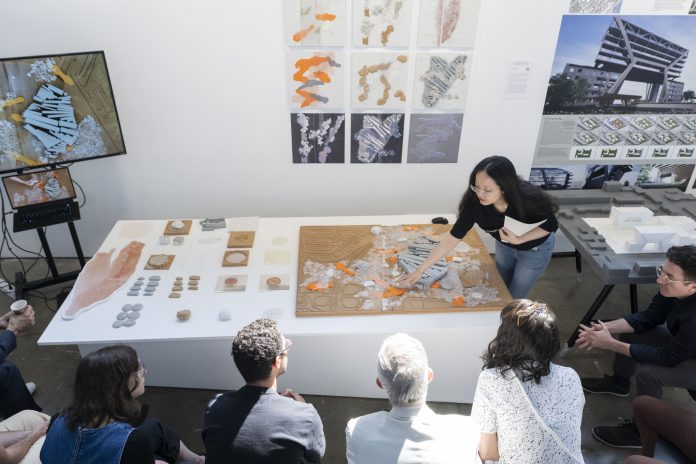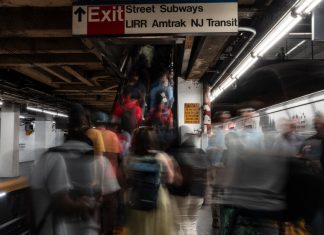Architecture is being reshaped by artificial intelligence, climate change, and shifting social structures. At SCI-Arc, students learn to face these challenges head-on, using design to shape a rapidly changing world.
This fall, SCI-Arc’s upper-level Vertical Studios bring the world into the studio. Each is led by a practicing architect working at the forefront of the field—from experimental fabrication to urban and environmental design. Drawing on real projects and professional experience, faculty challenge students to engage with the realities of the present and to design with precision, empathy, and imagination.
Intelligence Everywhere: Rethinking Creativity in the Age of AI
Artificial intelligence is transforming how architects think, make, and imagine. At SCI-Arc, it isn’t treated as a replacement for creativity but as a partner that expands it.
In the Synthetic Landscapes studio, David Ruy asks students to reconsider what “nature” means when machines are part of it. Using generative tools and simulation software, students this fall are exploring how technology and ecology intertwine—producing new kinds of environments that are both artificial and alive. In Interface Architecture, M. Casey Rehm examines how intelligence can be built into the spaces we inhabit. Working with the audio innovation company L-Acoustics, students design responsive environments that translate sound and motion into architecture. The work blurs the line between digital and physical experience, redefining what it means for a building to listen, sense, and adapt.
Across these projects, students confront the ethical and creative dimensions of AI. They learn that designing with intelligence also means designing with awareness—of tools, systems, and their impact on human experience.
Designing for a Planet in Crisis
Climate change has made architecture’s responsibilities impossible to ignore. At SCI-Arc, students are asked to confront that reality directly, using design to question, visualize, and respond to the planet’s shifting conditions.
In Earth Machine, Jennifer Chen collaborates with NASA JPL and Caltech to merge architectural design with planetary science. Students use satellite data and film to imagine new kinds of climate missions—projects that reframe architecture as a tool for observation and adaptation. In After the Fire, distinguished faculty member Eric Owen Moss begins not with theory but with loss. His students design for the wildfire-scarred terrain of the Pacific Palisades, proposing new ways to rebuild communities erased by disaster. The studio explores how architecture can help restore both landscape and identity.
Together, these courses form a call to action. They demonstrate that design is not separate from environmental crisis—it is one of the few ways we can begin to reckon with it.
Repair and Resistance: Architecture as Civic Work
Architecture is inherently political. It reflects the systems we live within and offers a way to question them. SCI-Arc‘s studios encourage students to treat civic and social issues not as abstractions but as opportunities for invention and care.
In The Postwar Machine, faculty members Anna Neimark and Dutra Brown focus on the West Los Angeles Veterans Affairs campus—a complex landscape of public land, historic buildings, and bureaucratic neglect. Students investigate how architecture can expose and repair institutional systems by designing spaces that restore civic purpose and dignity. In Assembly, Dwayne Oyler examines how parts come together to form a whole, both physically and socially. His students design projects that explore construction as a metaphor for community, proposing forms of architecture that emphasize collaboration, participation, and shared agency.
These studios position architecture as an act of civic imagination that requires as much empathy as precision. Students learn that to build responsibly is to engage with the social fabric that buildings inevitably shape.
Los Angeles: A City Always in Progress
Los Angeles has always been a complex city of contradictions. For SCI-Arc, it is both a campus and a collaborator—a place where the forces shaping the world play out in real time.
In Off-Center, Undergraduate Program Chair Kristy Balliet uses Exposition Park and the city’s preparations for the 2028 Olympics as a framework to explore movement, balance, and public experience. Her students design civic spaces that question how global events transform urban identity while celebrating the unpredictability that defines Los Angeles itself. Other featured studios—from those addressing wildfire recovery to projects reimagining civic institutions—also draw directly from the city’s evolving context. Los Angeles becomes a proving ground for design that is responsive, inclusive, and unafraid to experiment.
Here, students learn that to study architecture in Los Angeles is to study transformation itself. It is a city that refuses to stand still—and so does SCI-Arc.
A New Model for Architectural Education
The future of architecture demands new ways of thinking, building, and imagining. SCI-Arc invites students to join a community of designers who approach the world with curiosity and conviction. Discover how you can shape what comes next at their website.







